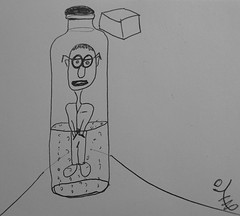 Image by Mac(3) via Flickr
Image by Mac(3) via Flickr
Economic Tightrope
Thought I’d throw a link and a sample of what you’ll find when you click it.
Written by Edward Hugh, it’s a great piece (well-linked and referenced with a few interesting charts) about the perils we face if we don’t walk this economic tightrope just right.
.
From Fistful Of Euros
Basically the risk of entering a liquidity trap is heightened when interest rates are at or near zero, and domestic demand contracts with sufficient force to produce a substantial and ongoing fall in prices, since the implicit rate of return on simply holding cash is not that different from that obtained by holding short term government bonds, especially when transaction costs are taken into account. (If prices drop at a 2% annual rate, for example, this gives you an implicit rate of return of 2% on bank notes).
Now we need to be careful here, since while monetary policy in one economy after another is gradually coming to rest around the zero bound, by and large price inflation has not (yet) fallen below zero (or not for a sufficient length of time), and while it is evident that a number of countries face the imminent risk of this happening (Germany, Spain, Ireland, the UK, Japan and the United States most notably) we are not there yet, and the central banks are working furiously (well I’m not too sure about the ECB) to unblock the credit crunch before the associated contraction in economic activity produces the sort of price deflation which increases the risk of one country after another getting stuck in some kind of liquidity trap.
[…]
The core of Krugman’s analysis is the idea that the equilibrium real interest rate – that is, the real rate that would match saving and investment – and thus bring output back up towards its capacity level – turns negative in a liquidity trap. Thus we can have an economy which is struggling to find its equilibrium point but which is unable to do so since it effectively cannot generate the rate of interest which would make this possible.
But how can the equilibrium real interest rate be and remain negative? Because, argues Krugman, poor long-run growth prospects (a debt deflationary environment) make investment demand so low that a negative short-term real interest rate would be needed to match saving and investment. Given a nominal interest rate floor of zero a positive expected rate of inflation becomes necessary to generate negative real interest rates, which will stimulate aggregate demand and restore full employment.
Equally importantly, injections of liquidity by the central bank which raise base money (or bank reserves) turn out to be pretty ineffective in raising the growth rate of broader money aggregates. Krugman shows that Japan’s monetary base grew 25% from 1994 to 1997, but that the broader monetary aggregate (M2 + Certificates of Deposit) grew only 11%, and bank credit didn’t grow at all. And more recent statistics indicated that “money hoarding” continued to be evident in 1998-1999, as an expansion of the monetary base in the range of 8% to 10% resulted in only about a 3% growth in M2 + CDs. Posterior Bank of Japan data show that between March 2001 and May 2004 while Japanese bank reserves grew by 800% the monetary base (which is bank reserves plus cash in circulation) only increased by 67%.
Click that link up there and read it all.
I am Jon. Watch your step.


